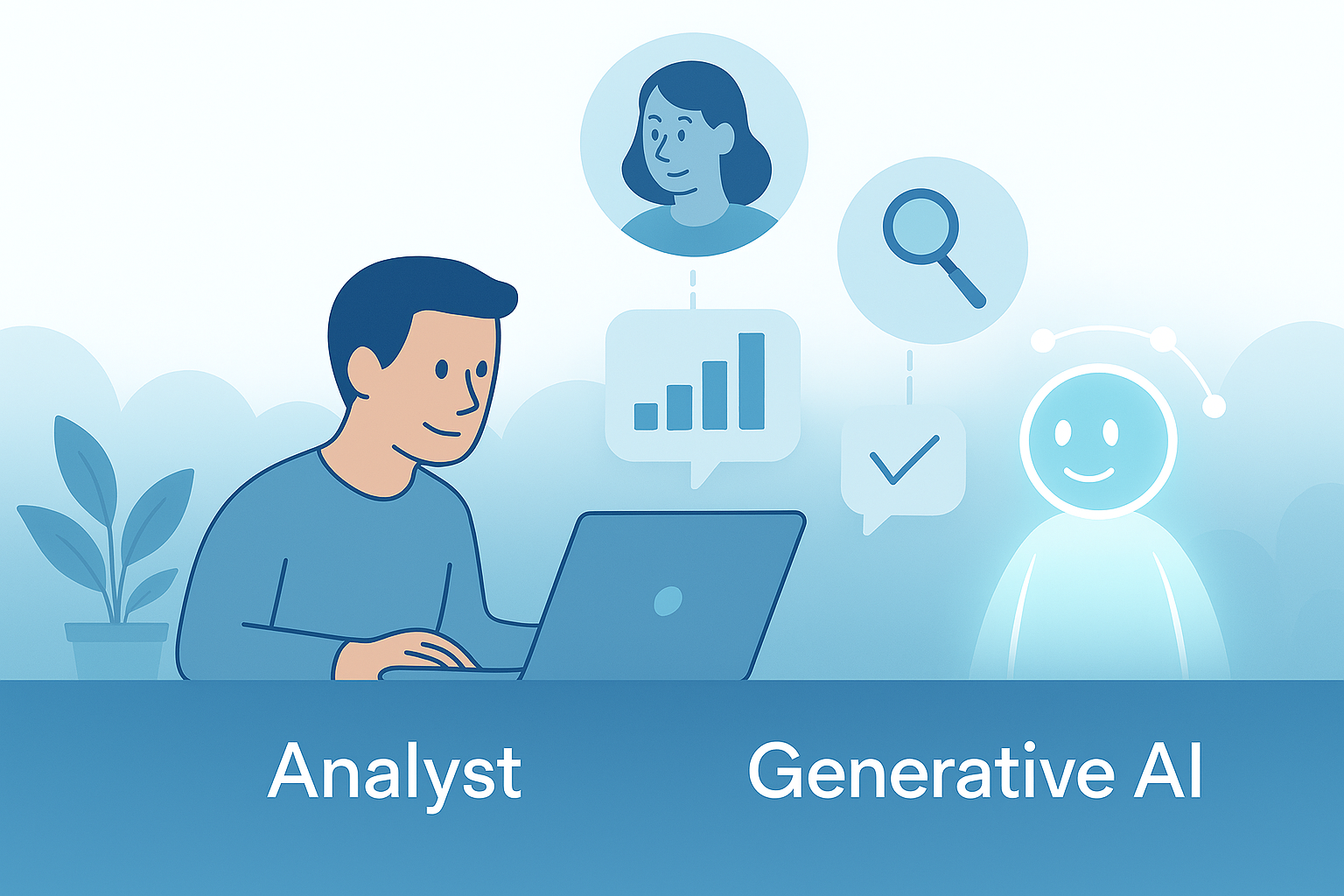Chat-based AI assistants have already moved the needle for knowledge workers who’ve embraced the generative AI shift. They’ve shortened time-to-first-draft, sharpened summarization, made research far more efficient, and, in some cases, reduced the need to extend or maintain sprawling legacy code by wrapping it with smarter interfaces. Most importantly, they’ve set the stage for what comes next: Analyst-Agent Pair. The model where a human analyst steers outcomes while a software agent executes repeatable steps inside clear guardrails.
A larger opportunity has emerged with agentic workflows. These systems plan, call tools, and take action to allow teams to move faster and improve the quality of their work. Much like DevOps accelerated delivery by reshaping who owns what and how work flows, the win here comes from new pairings and simple rituals. A human domain expert who defines the outcomes, steers when needed, and approves, and an agent that does the busy work and shares its activity along the way. Done right, this model saves time where it matters, reduces operational risk, and makes results explainable so impact can scale without scaling headcount linearly.
The Pairing Model

Picture a small team built from pairs where each domain Analyst is partnered with their own AI agent.
Analyst (Human). The Analyst owns the outcome. They set goals, define what “good” looks like, and make the final call on edge cases. As the workflow steward, they keep the playbook clean, set simple guardrails (what the Agent may do and when to ask), and maintain quality checks that run weekly. It’s not a new job family, just a new set of light responsibilities that keep the system improving.
Agent (AI). The Agent is the execution layer. It plans steps, calls tools, drafts artifacts, and proposes updates within the guardrails the Analyst set. When uncertain or blocked on a rule or policy, it always raises a flag with a clear reason and the evidence it used so the Analyst can review quickly and move on.
How they work together. The Agent executes the repeatable parts; the Analyst steers, clears exceptions and flags, and folds lessons back into the playbook. As volume grows, the stewardship duties can shift to a part-time owner, but the pairing stays the same: the Agent executes; the Analyst steers and is responsible for improvement.
Looking Ahead
As multi-agent composition becomes more common, orchestration adds both capability and complexity, making clear ownership and evaluation even more important.
Analyst and Orchestrated Agents. To address the complexity, the Pairing Model can extend to a composed team of agents coordinated by an orchestrator. An “Agent” then becomes a purposeful set of specialists with clear roles, shared memory, and explicit handoffs. The orchestrator plans, delegates, and reconciles results, allowing the Analyst to steer a single accountable unit rather than chasing multiple disjointed processes.
These orchestrated systems introduce new layers of coordination, delegation, and accountability across multiple agents and shared tools. This is an emerging operational consideration that many teams and technical approaches are only beginning to address. We will explore these topics further in a future article.
Day-in-the-Life Examples
Claims Analyst + FNOL Agent (insurance)
It’s 8:30 a.m. and the FNOL queue is already pre-processed. First notice of loss (FNOL) is the initial report a policyholder or partner submits to alert the insurer that an incident has occurred, and a claim may follow. Overnight, the Agent extracted key fields, verified policy status, ran basic fraud and coverage checks, and assembled a triage note with the sources it used. The Analyst opens a short, prioritized list of cases with ambiguous facts, unusual coverage, or potential fraud signals. The Analyst then and spends time where judgment matters: approving triage, requesting clarifications, or escalating edge cases. Every action leaves a clean trail of what changed and why.
What changes is the rhythm. Instead of skimming every attachment and chasing missing details, the Analyst reviews exceptions, not everything. Compliance sees consistent evidence. And improvement becomes steady: when a miss appears, the Analyst tweaks a threshold or adds a simple rule so the Agent gets a little smarter each week.
Sales Ops Analyst + Pipeline Hygiene Agent (sales)
It’s Tuesday morning and the pipeline is already tidy. Pipeline hygiene is the set of routines that keep CRM data trustworthy; deduplicating accounts and contacts, enforcing stage definitions, and ensuring follow-up commitments are met so opportunities don’t stall. Overnight, the Agent compared records, spotted duplicates, checked activity history, and drafted proposed merge activities with evidence (matching accounts, overlapping contacts, similar engagement). It also flagged aging opportunities at risk of follow-up misses (e.g., no response to a new lead within two business hours, no touch in Discovery for 5 days, or 14 days of inactivity in Proposal) and prepared gentle nudge emails for reps.
The Analyst opens a short, prioritized queue and spends time approving safe merges in bulk, correcting edge cases, or adding a note for a rep. Every change carries a rationale and links back to the underlying records.
Instead of hunting for problems across dashboards, the Analyst focuses on a clear set of exceptions. When a false positive appears, they tweak a rule or threshold so that next week the Agent produces even cleaner data.
FP&A Analyst + Forecast Reconciliation Agent (finance)
Midweek in FP&A brings a fresh round of forecast updates. Financial Planning & Analysis (FP&A) teams explain why numbers moved (by cost center, region, or product) and reconcile versions that don’t quite match. Overnight, the Agent pulled variances from source systems, aligned them to the current chart of accounts, surfaced the biggest movers, and drafted commentary with cited drivers (e.g., “vendor rate increase,” “shifted deployment date,” “currency impact”), all tied back to the underlying data.
The Analyst lands on a concise, ranked worklist that includes only items that need expert judgement – ambiguous drivers, conflicting regional inputs, or surprising swings. They refine the draft language, request clarification where evidence is thin, and sign off. Each edit is logged with links to the sources, so leadership can trace “what changed” without a spreadsheet hunt.
The overhead drops, but so does risk. Instead of assembling notes from scattered files, the Analyst focuses on explanations that matter. When a mismatch slips through, they add a small check (a rule for currency thresholds or sanity checks for headcount changes). By the next cycle, the Agent incorporates the fix, and the commentary arrives cleaner and faster.
Practices That Make the Pairing Model Work
Even the best partnerships could use a set of best practices. Three lightweight best practices can help evolve simple automation into dependable operations:
- Evaluations (prove it works before you scale)
- Observability (see what happened and why)
- Guardrails (keep actions safe and reversible)
Evaluations
Run two kinds of tests every week: task-level checks (did the Agent get it right, cite sources, and stay within scope?) and scenario tests (can it handle edge cases, ambiguous inputs, and a few deliberately adversarial prompts?). Keep the set small but stable so you can see progress and regressions. The Analyst curates the cases, and a lightweight automated runner produces a simple scorecard that includes accuracy, citation coverage, exception rate, time-to-decision. Promote changes to the only when the evaluations pass reliably.
Observability
If you can’t replay a result, you can’t trust it. Log the plan the Agent followed, the tool calls it made, the sources it retrieved, the decisions it took, and the outcome. This is lightweight plumbing, not a SIEM (Security Information and Event Management platform): you want just enough detail to replay a task and explain “what happened and why,” not an enterprise-scale security telemetry stack. With that visibility, teams can spot drifts in cost, latency, or exception rates. And when something goes wrong, you fix the playbook with evidence, not guesswork. More information about how to implement Agent “memory” that can enable visibility can be found in one of our recent posts: “Practical Memory Patterns for Reliable, Longer-Horizon Agent Workflows.”
Guardrails
Start simple: allow lists for tools, policy checks before retrieval or write-backs, basic rate limits, and one or two approval points where the Agent must ask. As confidence grows, you can expand gradually. More granular permissions, tighter data-region rules, smarter thresholds. The point isn’t to block action; it’s to make risky actions reviewable and revocable.
How they reinforce each other
Evaluations tell you if the system is reliable, observability shows why a result happened, and guardrails limit how it can go wrong. Together, they create a fast loop: issues show up in the evaluations, you trace them via the logs, you fix them by adjusting rules or the playbook and then re-run the tests to confirm.
Anti-Patterns to Avoid
There are traps that will stall your Analyst-Agent pair no matter how good your metrics are or how hard you try to align to a good best practice in your process. Here are a few to watch for and what they may look like in practice.
“Shadow Agents” (no observability, no evaluation)
Agents quietly ship artifacts with no way to replay decisions or catch regressions. When something goes wrong, you’re debating “vibes” instead of evidence. Example: In FP&A, a variance draft changes week to week and no one can explain why. There’s no task log (what tools, what sources) and no weekly evaluation run.
Automating the entire process at once
If the Agent can’t ask for help, it will either guess or stall, and both can erode effectiveness and trust. Design the exception queue as a first-class step. Example: In FNOL, the Agent tries to classify every claim, including policy edge cases. Errors leak into the queue for human cleanup late in the day.
Tool sprawl without guardrails or ownership
New connectors and prompts multiply, but no one owns the playbook or the rules. Latency spikes, costs drift, and policy violations start showing up more frequently. Example: In Sales Ops, multiple enrichment APIs run on every record update. Results conflict and deduplication rules diverge by team.
Treating Agents as people replacements instead of capacity multipliers
At some point you may be tempted to skip Analyst reviews to save time. You may save time – until a bad recommendation lands in a board deck or audit finding. Example: To speed things up, the team removes Analyst review on dedupe merges. A few incorrect merges slip through, contacts get lost, and forecasts wobble.
The bottom line: avoid hidden work, design the exception path first, put simple rules and ownership around tools, and keep the Analyst in charge of outcomes.
Metrics that Matter
What’s worked for us to this point (and admittedly, we are early in this journey) is to keep the score simple and stable. A useful way we’ve found to think about it is to track three buckets; Adoption, Effectiveness, and Trust. And then we pick a couple of signals in each, tie them to one Analyst-Agent pair’s workflow, and report the same way every month. The consistency matters more than the exact metric mix, as you learn what matters most over time. Examples each bucket:
Adoption
- Agent-assisted workflow percentage. Share of targeted processes running with the Analyst-Agent pairing. Example: Move Claims triage and FP&A variance commentary to >50% agent-assisted within one year.
- Analyst Satisfaction. A quick three-question pulse: “The agent saves me time,” “Exceptions are clear,” “I trust the citations.” Example: In Sales Ops, raise “saves me time” from 3.2 to 4.3/5.
- Orchestration handoff success rate. The share of delegated steps that return a valid, cited result without human intervention. Example: keep handoff success at ≥85 percent while volume grows.
- Exception rate trend. Are we creating work or removing it? Example: In FP&A, hold exceptions at <15% of drafts while total volume grows.
Effectiveness
- Time-to-decision. How long does it take to get to an approved outcome when a task is opened? Example: In FNOL, cut the average triage time from 2h to 25m once the agent pre-processes overnight and the Analyst works a short exception queue.
- Rework Percentage. Outputs needing more than one Analyst touch. Example: In FP&A, keep variance comment re-edits <10% after the agent’s first draft with cited drivers.
- Exception closure time. Simply the time it takes to clear an exception once raised. Example: In Sales Ops, close “potential duplicate” exceptions within four business hours via bulk approvals.
Trust
- Citation coverage. Percentage of agent assertions backed by a source the Analyst can click and verify. Example: In FP&A, require ≥90% of variance explanations to include links to source systems or documents.
- Policy check effectiveness (“safe stops”). When rules correctly stop an agent’s action (e.g., missing consent, out-of-region data, write-back needs approval). This is a good outcome that can drive improvement. Example: In FNOL, target ≥95% safe-stop precision (most stops are appropriate).
- False alarms vs. missed issues. Track how often the agent flags something that isn’t real (false alarm) versus fails to flag something it should (missed issue). Example: In Sales Ops deduplication, aim for <5% missed duplicates on a weekly sample (and keep false alarms low enough that bulk-approvals still save time).
- Task misalignment rate. Percentage of tasks where the agent’s plan or output does not meet the stated goal or acceptance criteria on first pass. Example: hold misalignment below 8 percent on a weekly sample and trending down.
Closing
DevOps didn’t have such a substantial impact because of a revolutionary tool; it was because ownership and rituals changed. Reliability stopped being “Ops’ problem,” and delivery stopped being “Dev’s problem.” When it worked well, shared dashboards, productive collaboration session, and small, steady releases unlocked both speed and safety.
We’re at a similar moment with agents. Analysts own outcomes and improvement while agents own repetitive execution. When you add shared rituals like daily exception reviews, weekly evaluation, and monthly guardrail checks, you can unlock more reliable automation without growing headcount linearly. The payoff can be similar to the value achieved when DevOps is done well: fewer surprises, faster cycles, and a system that gets better every week.
This is a team design problem first, not a “best model-shopping” exercise. If you remember one thing: pair a human Analyst with your AI agents and arm them with good guidance and practices (evaluations, observability, guardrails) to maximize the chances of returning real value.






